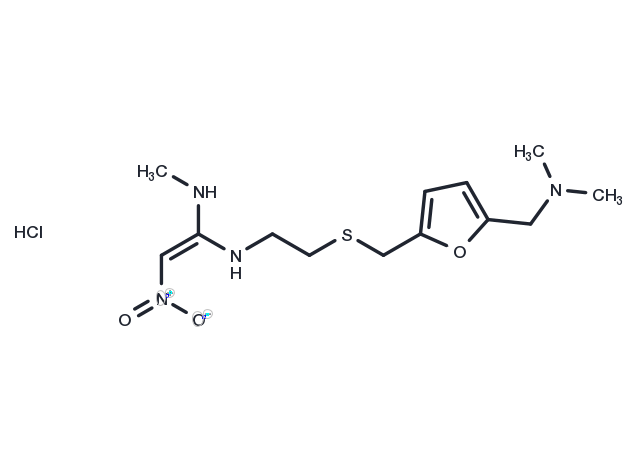Powder: -20°C for 3 years | In solvent: -80°C for 1 year
Ranitidine Hydrochloride (AH19065) is a member of the class of histamine H2-receptor antagonists with antacid activity. Ranitidine is a competitive and reversible inhibitor of the action of histamine, released by enterochromaffin-like (ECL) cells, at the histamine H2-receptors on parietal cells in the stomach, thereby inhibiting the normal and meal-stimulated secretion of stomach acid. In addition, other substances that promote acid secretion have a reduced effect on parietal cells when the H2 receptors are blocked.

| パッケージサイズ | 在庫状況 | 単価(税別) | |||
|---|---|---|---|---|---|
| サンプルについてお問い合わせ | |||||
| 25 mg | 在庫あり | ¥ 7,000 | |||
| 50 mg | 在庫あり | ¥ 10,000 | |||
| 100 mg | 在庫あり | ¥ 13,500 | |||
| 200 mg | 在庫あり | ¥ 15,500 | |||
| 500 mg | 在庫あり | ¥ 18,500 | |||
| 1 mL * 10 mM (in DMSO) | 在庫あり | ¥ 15,000 | |||
| 説明 | Ranitidine Hydrochloride (AH19065) is a member of the class of histamine H2-receptor antagonists with antacid activity. Ranitidine is a competitive and reversible inhibitor of the action of histamine, released by enterochromaffin-like (ECL) cells, at the histamine H2-receptors on parietal cells in the stomach, thereby inhibiting the normal and meal-stimulated secretion of stomach acid. In addition, other substances that promote acid secretion have a reduced effect on parietal cells when the H2 receptors are blocked. |
| ターゲット&IC50 | H2 receptor:3.3 ± 1.4 μM |
| In vitro | Ranitidine sensitizes hepatocytes to killing by cytotoxic products from activated neutrophils, whereas Famotidine lacks this ability. [1] Ranitidine inhibits the production of tumor necrosis factor-alpha (TNF-alpha) in monocytes stimulated with lipopolysaccharide in vitro. [2] Ranitidine reduces the Kel of morphine dose-dependently with a maximum effect of 50%, and increases the relative concentration of morphine-6-glucuronide to morphine-3-glucuronide in isolated guinea pig hepatocytes. Ranitidine gradually decreases the morphine-3-glucuronide/morphine-6-glucuronide ratio by up to 21%. [3] |
| In vivo | Ranitidine results in liver injury as evidence by increased in serum alanine aminotransferase, aspartate aminotransferase, and gamma-glutamyl transferase activities within 6 hours after Ranitidine administration in rats. [1] Ranitidine inhibits hepatic ischemia/reperfusion-induced increase in hepatic tissue levels of TNF-alpha, cytokine-induced neutrophil chemoattractant, and hepatic accumulation of neutrophils in rats. [2] Ranitidine cotreatment enhances LPS-induced coagulation prior to liver injury, and anticoagulants reduce liver damage in LPS/RAN-treated rats. Ranitidine /LPS-treated rats results in the formation of fibrin clots in liver sinusoids, and prevention of fibrin deposition associated with reduced hepatocellular injury. Ranitidine cotreatment enhances the LPS-induced TNF increase before the onset of hepatocellular injury in rats. [4] Ranitidine displays anxiolytic effects in the elevated plus-maze as indicated by an increase in time spent in the open arms, more open-arm scanning and more end-excursions in rats. [5] |
| 別名 | AH19065 |
| 分子量 | 350.86 |
| 分子式 | C13H23ClN4O3S |
| CAS No. | 66357-59-3 |
Powder: -20°C for 3 years | In solvent: -80°C for 1 year
H2O: 142.51mM
DMSO: 60 mg/mL (171.01 mM)
You can also refer to dose conversion for different animals. 詳細
bottom
Please see Inhibitor Handling Instructions for more frequently ask questions. Topics include: how to prepare stock solutions, how to store products, and cautions on cell-based assays & animal experiments, etc.
Ranitidine Hydrochloride 66357-59-3 GPCR/G Protein Immunology/Inflammation Metabolism Microbiology/Virology Neuroscience Histamine Receptor P450 Antibacterial AH19065 inhibit secretion AH 19065 Gastric CYP2C19 Ranitidine CYPs CYP2C9 Cytochrome P450 H2-receptor Inhibitor AH-19065 Bacterial orally inhibitor
